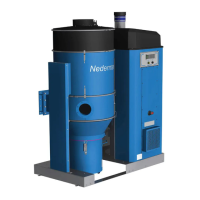FlexPAK 800/1000
EN
18
WARNING! Explosion risk.
• Do not collect material that may cause ignion or blocking. It is strictly prohibited to
collect material that may undergo dangerous chemical or thermal reacons and/or self-
ignite.
• Some types of dust may cause a dust explosion and/or re. Before installaon,
invesgate whether the dust to be collected by the system constutes a risk.
• The silencer outlet for exhaust air is to be directed upwards. Fit a Spiro duct to direct
the exhaust into the atmosphere. The duct is to be routed to prevent any parcles from
falling into the unit, which could cause serious damage
• Self-ignion can occur with some types of dust. Under no circumstances may magnesium
and tanium dust be sucked into the system.
NOTE! All connected ducts are to be conducve and grounded.
5.3.2 Recommendaons
Transport velocity
It is important to use the correct duct diameter to avoid pressure losses and dust deposits
in the duct system. Ensure that the correct transport velocity is achieved. Correct velocity
depends on the properes of the transported material. Some applicaons may require
velocies up to 25 m/s (82 /s). Take velocity into account when choosing duct diameters.
The velocity is never to decrease on the way to the unit. The transport velocity in the ducts
may vary depending on how much of the vacuum system is used.
Flushing
Depending on the type of dust and fumes to be ltered by the unit, a principle called
ushing may be used to keep the vacuum ducts clean. Flushing may be applied by ng a
valve at the end of the duct system. By not using the rest of the system, and opening the so
called ush valve, a high amount of air will ush the ducts clean. By ushing each branch of
the vacuum system separately, the risk of dust deposits is minimized.
In larger vacuum systems with mulple units installed, the installaon of Duct Isolaon
Valves (DIV) is recommended in order to isolate one unit for maintenance while the others
remain in normal operaon.
If the dust is abrasive, it may be necessary to use thick-walled (or rubber coated) material
in bends and other exposed areas.
To avoid pressure losses, the duct system is to be as short as possible and designed with
two or more branches. Use larger diameters on the clean side to reduce pressure losses.
5.4 Installing the unit
WARNING! Risk of personal injury.
Always stop the unit before looking into the outlet. The fan rotates at high speed and
debris and parcles coming out of the outlet may cause eye injury.
5.4.1 Indoor installaon
CAUTION! Risk of equipment damage.
If the exhaust air duct is blocked, the unit may create an overpressure, which may cause
major damage to the heat exchanger.
NOTE! Never completely seal a small room with the unit installed.

